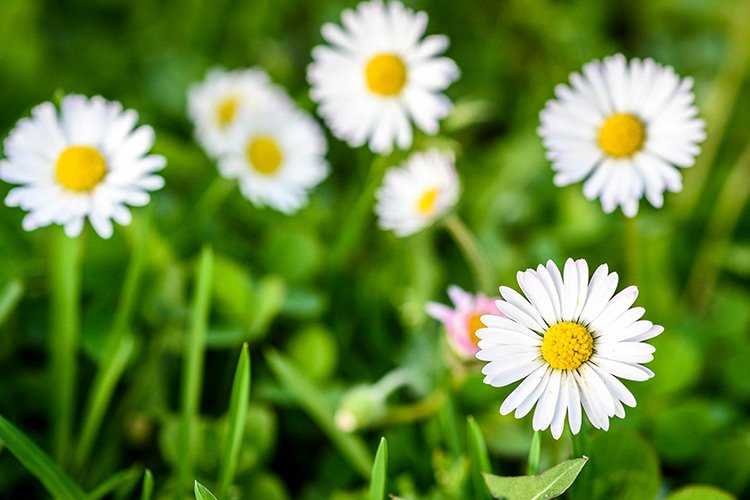Beautiful Plants For Your Interior

How to Remove Daisies From a Lawn
How to remove daisies from a lawn? English daisies (bellis perennis) are a common lawn weed, daisy type flowers are easily recognised by pretty, small, white-petalled flowers with a round yellow centre, spreading from one location to another via seed.
In short, to get rid of daisies from your lawn, you can use a daisy grubber, one of the top tools used. This specialised tool is used to ‘pry’ daisies out of the ground.
A daisy grubber is a handy tool, though, that you can use to remove stray daisies and other short-rooted weeds from your lawn.
These tools are hand-crafted and made from high-quality stainless steel. They are effective at removing stray daisies and other weeds, and they have a comfortable contoured handle.
These tools are designed to do minimal damage to your lawn. The blade of a daisy grubber enters your lawn in a “V” shape, causing the least damage. The blade is usually made of stainless steel and is strong enough to cut through deep roots.
Pulling them out by hand, however, can leave ‘bits’ of root still embedded in the soil. Using a ‘grubber’ can make this task easier.

Daisies are easily recognised: Small, white-petalled flowers, with round yellow centres
The English Daisy is a Perennial
English daisies are native to western Asia and Europe. They have now spread to the United States and other countries including Germany, France, Slovakia, and Chile.
This post will discuss the advantages and disadvantages of English daisies and how to remove them from a lawn.
English daisies are on the list of common UK weeds and are susceptible to leaf miners and thrips, which feed on the foliage and leaves of this plant.
Affected English daisies will look unhealthy and ragged. Using a horticultural oil to prevent thrips from eating the daisy’s foliage and spreading, can help further spread. And don’t forget to remove them from your lawn though once seen.
Daisies Spread via Seed – Cultivation
Daisies, maybe for you? It’s your garden, your own lawn and your choice the debate on this topic could rage on for a while, both on and offline.
Daisies are though a perennial plant that grows by spreading seeds. Daisies need abundant sunlight and good drainage to thrive just like your lawn, they also prefer rich, fast-draining soil.
Soil pH should be between 6.0 and 8.0 to provide the best growing environment. Daisies require good moisture and fertiliser during the early growing stages. If necessary, apply a general fertiliser monthly to keep the soil pH levels neutral.
Daisy seeds disperse in the wind around the parent plant. Birds and ants may carry them as well. People can also spread seeds by dragging mud on their shoes. Earthworms, which feed on dead plants, can eat and recycle the seed. They increase the seedlings’ germination by up to 93%.
Runner-like growths, called stolons, emerge from the first rosette leaf and then spread from there. They can also form ‘clonal’ patches on lawns ie..” clonal propagation”
It is a Weed of Lawns
If you want to get rid of daisies from your lawn, or flowers that look like daisies, there are several treatment methods you can use. Mechanically, you should dig up ‘rosettes’ and pull them up with a ‘daisy grubber’ as explained above.
To prevent the regrowth of daisies, maintain a high sward (an expanse of short grass) to reduce bare soil, lawn weeds and daisy ‘seed’ from germination.
There are several other methods of removing daisies from your lawn. If you can identify daisies by their white petals and yellow centres, you have a problem with ‘close mowing’. Most people mow their lawns too close. This causes thinning, weed and moss invasion, disease and premature drying.
Luckily, various weed-killer products can effectively kill off daisies without harming the grass. You can try Resolva Lawn weedkiller for lawn areas or a lawn feed and weed product. This works without harming the lawn.
Care should be taken to ensure you use these products correctly, read the product labels carefully and use the right one for your lawn. You should apply this product to your lawn after it has germinated and as advised on the package.
Daisies are notoriously difficult to eradicate once they’ve become established, so lawn care is essential, but don’t lose hope.
How to Remove Daisies, Daisy-Type Flowers and Other Weeds From Your Lawn: The Hard Way
How to Remove Daisies From a Lawn – It is difficult, but not impossible
How to Remove Daisies from Your Lawn: Recap
- Hand-pulling: The most effective way to remove daisies from your lawn is by hand-pulling. This involves grasping the daisy at its base and pulling it out, roots and all. Make sure to wear gloves and use a weeding tool to help you get a better grip on the weed.
- Chemical control: You can also use chemical weed killers to remove daisies from your lawn. Choose a weed killer that is specifically designed for broadleaf weeds like daisies. Follow the instructions on the package carefully, and be sure to apply the weed killer when there is no wind or rain in the forecast.
- Lawn maintenance: The best way to prevent daisies from taking over your lawn is to maintain a healthy and well-fed lawn. A healthy lawn is less susceptible to weeds and can naturally outcompete them. Fertilise your lawn regularly, mow it at the correct height, and water it deeply and infrequently.
Tools Needed for Removing Daisies from Your Lawn:
- Gloves
- Weeding tool
- Chemical weed killer (if desired)
- Lawn fertiliser
FAQs
Can Daisies be Composted?
Yes, daisies can be composted, but it is best to avoid composting the ones that have been treated with herbicides.
Can I Use a Pre-emergent Herbicide to Prevent Daisies From Growing?
Yes, you can use a pre-emergent herbicide to prevent daisies from growing on your lawn. However, it is important to follow the instructions on the package and apply the herbicide at the correct time to prevent damage to your lawn.
How Long Does it Take to Remove Daisies From a Lawn?
The time it takes to remove daisies from your lawn depends on the size of the infestation and the method you choose. Hand-pulling can take several hours while using a weed killer can take a few weeks to see results.
Can I Use Vinegar to Remove Daisies From my Lawn?
While vinegar can be an effective weed killer, it can also harm your grass if not applied properly. It is best to use a herbicide specifically designed for broadleaf weeds like daisies.
Conclusion
The best time to take out daisies from your lawn is when they are young and have not yet flowered as flowering daisies produce more seeds, making it harder to control their spread.
Remember, herbicides work best when applied in late spring or early summer when the new growth of the weeds is visible.
Daisies may be a common weed in lawns, but they can be effectively removed with the right tools and techniques. Hand-pulling, chemical weed killers, and lawn maintenance can all help to rid your lawn of these common weeds.
By following the guidelines in our comprehensive guide, you can have a beautiful, healthy lawn that is free of daisies. Remember, prevention is key, so be sure to maintain a healthy lawn to prevent future infestations.
If this post has helped you in any way, please share it with your family and garden-loving friends or anybody looking to know to find out ‘How to Remove Daisies From Your Lawn’
Finally, you can always pop over to our general FAQ page to find out more about weed control, gardening, and a whole host of other answers to your gardening questions and queries.
